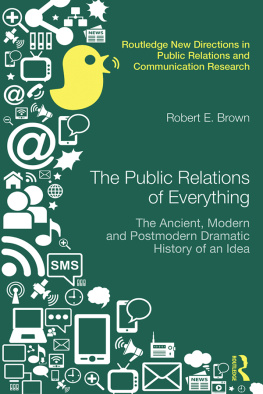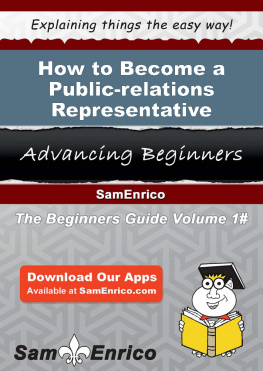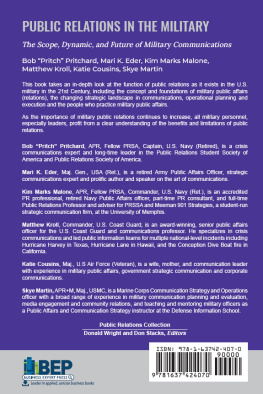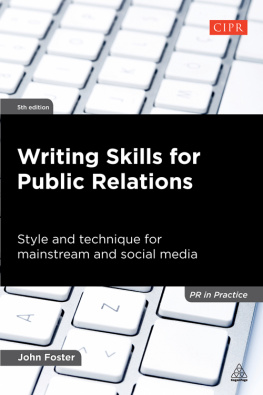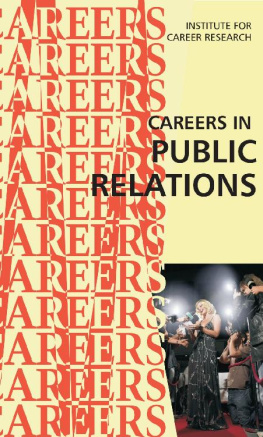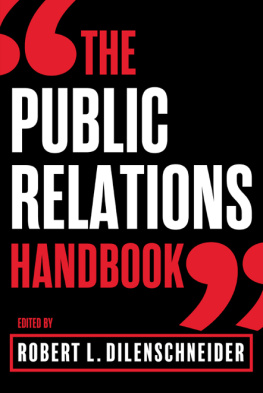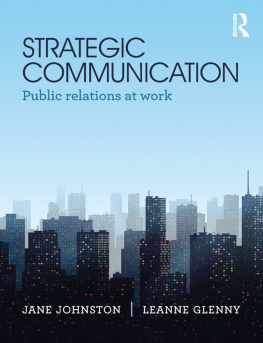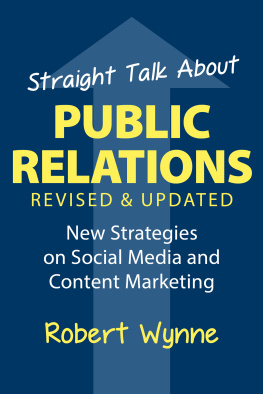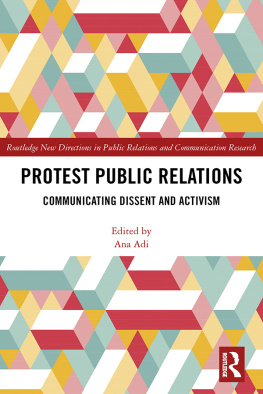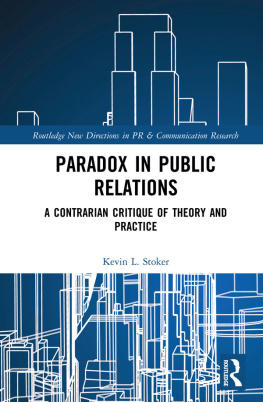My aim is to try to isolate some of the basic frameworks of understanding available in our society for making sense our of events I start with the fact that from an individuals particular point of view, while one thing may momentarily appear to be what is really going on, in fact what is actually happening is a plainly a joke, or a dream, or an accident, or a mistake, or a misunderstanding or a deception, or a theatrical performance.
Erving Goffman. Frame Analysis.
1
The principles of the public relations of everything
Authors are actors, books are theaters.
Wallace Stevens, Adagia
Almost everyone has an idea of what public relations (PR) is and almost everyone is half right. But theres another half. This book seeks to explain it.
The conventional wisdom about PR by its scholars, textbook writers and practitioners isnt incorrect. But neither is it sufficient. The conventional wisdom about PR is that it exists as something, somewhere and sometime. The thesis of this book is that the conventional wisdom is misleading. Far from the narrow confines of its conventional conceptualizations, PR comprises not only some things but everything, everyone, everywhere and every time. For many scholars, PR is a matter of answers; for me it is a matter of questions. It is not about whats distinctive, as PR textbooks and PR trade organizations have said, but whats inclusive. It is as much a product of the imagination as the result of logic. In fact, PR in the twenty-first century is rapidly becoming less and less distinctive as it continues to converge with those strategies from which it was purported to be distinct, such as marketing, advertising and other rhetorically charged strategies.
What follows are principles of the public relations of everything (PRe). Here I omit the definite article, the, to insist that the 20 principles are not meant to be definitive so much as indicative. These principles are intended to suggest ways to understand public relations in what has been called a postsymmetry age (Brown, 2010). An author who can conceive of 20 principles can imagine 20 more. Whats no less important than that number is the number-as-idea of multiplicity, multidisciplinary expansion and connection. It is an idea that challenges the old and ongoing attempt to define PR as this or that, rather than resist the idea that PR is both and more, growing outward rather than narrowing inward.
Principle 1: Public relations is ubiquitous, universal and timeless
Whatever it is, it must have
A stomach that can digest
Rubber, coal, uranium, moon, poems.
Like the shark, it contains a shoe.
It must swim for miles through the desert
Uttering cries that are almost human.
Louis Simpson (1963/2001); American Poetry
The public relations of everything, or PRe, questions the conventional wisdom that PR is exclusively a phenomenon of modernity, or technology, any more than perception, opinion, reputation and identity were born from the nineteenth century like Athena from the forehead of Zeus. Like the shark in the Simpson poem, PR is omnivorous. But unlike the poems title, the waters in which PR swims are not American but the oceans which touch the shores worldwide.
PR is new but its old. The advent of the Internet, and in the last decade, web culture and social media tools, have made an extraordinary impact on history, culture, organizations, society, individuals, relationships and PR. Historiographically, PRe moves beyond the flawed notion of PR as exclusively and definitively modern.
PRe rejects PRs conventional wisdom theory of symmetry as a vestige of the mechanical age with its faith that the PR machine, if properly oiled with good will, can balance the needs of unequally powerful parties. That symmetry theory is posited as normative turns out to be a dodge, or a way of insisting thats how PR ought to be even if it isnt. By contrast, PRe prefers the is to the ought.
In its obsession with technology, PR has forgotten McLuhans (1964) insight that technology is an extension of humanity. (He was, after all, not a professor of technology but of the transdisciplinary humanities.) Technologies, as well as opinion, influence, belief and awe, point to the individuals relationship with society (Brown, 2004; Gordon, 1997). PR is a social phenomenon, as are the typically cited rationales for PR practices: the creation, management and alteration of perception, opinion and reputation as they, in turn, affect the behavioral, economic and political situations of individuals, organizations and nations. But to posit humanity or PR as technology is the very meaning of reductive (Halpern, 2013).
PR has benefited from the insights of the social sciences. Yet despite the aspirations of PR to claim the status of a science, PRe regards PR as a humanity. ( makes this case in detail.) PRe understands PR in broadly inclusive, historical and personal terms. This is PRs ethos and its legacy, from Homers poetry to Aristotles rhetoric to Saint Pauls messianic persuasion to the Catholic Reformation Propagandio, and onward to modernity and the elegance of the algorithm.
PRe sees everything as human and everything as relational.
Principle 2: Public relations is experiential and contingent
The attention lavished by PR textbooks and scholars on planning, strategy, objectives, measurement and results misleads because it fails to account for the situation of PR. PR is no less bound than any other human and social institution by contingency. Indeed, management itself is an art, as the management theorist and ethnographer Henry Mintzberg (2005) concluded after observing managers in situ. Phenomenologically, PR is an art in the service of another art.
Everyday life is contingent, notwithstanding our effort to manage it. Or, as Kierkegaard said, our effort to distract ourselves from what we know. The Big Data we overlay upon that contingency produces statistical answers that are incapable of altering the foundation of our situation or that of organizations and their managers.
The experience as experience of people doing PR has not been an interest of the vast majority of PR scholars. Why has this been so? The project of the previous generation of PR scholarship has been to lift and separate PR from its taint of moral illegitimacy and intellectual unworthiness by building a collection of theories laid upon the putative foundation of science. Meanwhile, the practice of PR has thrived largely unaware of those theories.
In the phenomenology of Maurice Merleau-Ponty, lived, embodied experience is the source of meaning. But quite unlike the PR adage (or enthymeme ) that perception is reality, which ignores or trivializes experience, Merleau-Ponty made embodied experience the basis of perception and consciousness, and the starting point for all philosophical explorations (Merleau-Ponty, 1945/2012). Whats missing in much PR theory is the way in which Merleau-Ponty understood perception and experience. PR scholarship has too often been disembodied. In Merleau-Pontys phenomenology, everyday perception has merged with the aesthetic, in eye of the Cezanne (Merleau-Ponty, 1948/1964).
PRe questions the trope of the rational manager who plans, organizes and controls, which is the classic definition of management. For PRe, the assumptions of rationality run aground in a world of radical contingency, and the notion of management as a science is rebutted by the lived experience of practitioners and their managers themselves. In PRe, the compelling trope is not functionalism or mechanism or balance; it is drama.
When framed conventionally, PR becomes just another mechanical operation in the organizational wheelworks. But even the voluminous and capacious definitions of the Public Relations Society of America (PRSA; see www.prsa.org) and the U.K. Chartered Institute of Public Relations voluminous and capacious definitions of PR hardly object to the idea of PR as ubiquitous.

